 |
| Category:
WW2/Militia/AIF |

|
|
|
|
|
|
New Guinea Volunteer
Rifles Page 2 |
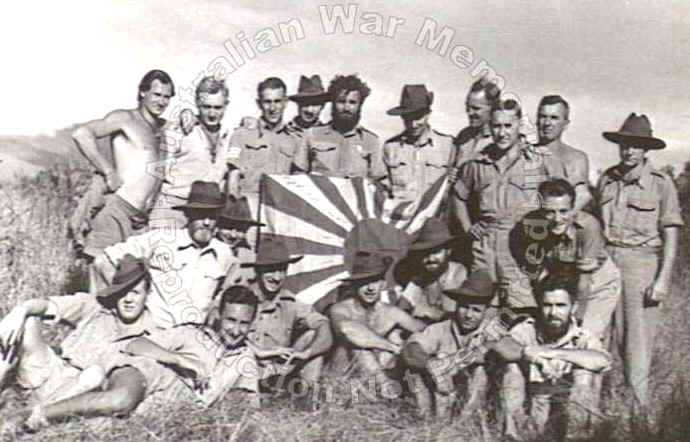 |
New
Guinea, 1942-08-28.
Members of B Company, New Guinea Volunteer Rifles, proudly display a
Japanese flag they captured at Mubo on 1942-07-21.
- Personnel
are (rank is rifleman unless stated otherwise)
- back
row from the left, NG2423
G.R. Archer, NG2192 J. Cavanaugh, NG2200 Sergeant L.E. Ashton,
NG2230 H.M. Shutt, NG2214 J.G. Kinsey, NG2113 F.L. Leather,
NG2191 Sergeant J.B. Macadam, NG2231 S.F. Burns, NG2114 I.H
Patterson, NG2068 J.C. Shay;
- centre
row, NG2461 R. Napier,
NG2234 C.L. Cavalieri, NG2380 A.R. Sheath (bending over);
- front
row, NG2201 Corporal J.A.
Birrell, NG2219 H.L. Harris, NG2022 Corporal A.McA. Graham,
NG2229 R.W.Doyle, NG2211 Sergeant H.J.W. Farr, NG2325 W. Allen
and NG2047 Corporal G.R. Rayner. (Negative
by Damien Parer)
|
|
The
History of the New Guinea Volunteer Rifles. |
Anyone
glancing at the Nominal Roll of the New Guinea Volunteer Rifles (NGVR) would
be excused for thinking that Australia had maintained a Foreign Legion
at its northern outposts in January 1942. Such names as Lars Waldamar
Bergstrand; Carlo Lugarno Cavalieri; Bruno Chou Lai; Alistair Stuart
Fraser-Fraser; Francisco Trojaolo and Hubert Behrendorff appear and are
an indication of the cosmopolitan nature of the volunteer movement.
When Army Headquarters,
on 4 Sept 1939, issued the necessary orders for the raising of this
unit, men from Europe, British Isles, New Zealand, Australia and Asia,
men who had their homes and livelihood in the Territory of New Guinea
and were aware of the menace of Japan, hastened to join. Chan Kim Thai
was a rifleman; Shui Hong, a Lieutenant.
Prior to the beginning of
the war, Australia had scrupulously observed its undertakings to the
League of Nations and had refrained from making any defence preparations
in the Mandated Territory of New Guinea. In spite of the limitations
imposed by the mandate, the Returned Soldier's League Sub-Branches took
a vigorous lead in demanding that at least some effort should be made to
arm and train those residents who wished to be better prepared to defend
themselves and their homes. Colonel J. Walstab, the Police Superintendent
at Rabaul, visited Melbourne in August 1939, and discussed the matter
fully with Army HQ. Largely because of his efforts, it was decided to
form a militia-type battalion in New Guinea. |
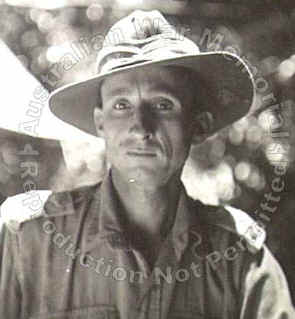 |
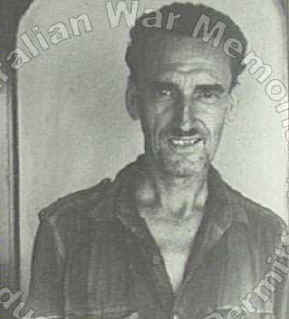 |
| Oiva
River, New Britain. 1945-02-07. NX151701 Major H.M. Lyon,
officer-in-charge, B Company, 1st New Guinea Infantry Battalion. Major
Lyon was previously a Company Commander in the New Guinea Volunteer Rifles.
He has lived in the territory for some 13 years and was employed by Guinea
Airways.
|
Port
Moresby, New Guinea. 1942-04-12. Sergeant S. Costello, New Guinea
Volunteer Rifles, an accountant of Rabaul in private life, one of the
evacuees who was successfully rescued by the HMAS "Laurabada"
from Palmalmal, photographed aboard the rescue ship.
|
| Originally, the strength
of the battalion was limited to 20 officers and 400 other ranks but the
establishment was increased in Jun 1940 to 23 officers and 482 other
ranks. The enthusiasm in the early days stemmed mainly from returned
servicemen of the 1914-18 War, but in mid-1941 the unit lost much of its
zest, many of the youngest and most ardent members having gone to join
the AIF and other services. The remoteness of many areas was a
disadvantage inherent in the unit's organisation. But, in the latter
half of 1941, a growing realisation of the danger of war in the Pacific
and the increasing peril of the Territory led to a revival of interest.
Headquarters of the NGVR was
originally at Rabaul and companies and sections were located at Wau,
Salamaua, Lae and Madang. Fit men between the ages of 18 and 50 were
accepted. Enlistment was for two year periods and there was no pay
except for an allowance of 1 Pound per year, made for each efficient
member - an efficient member being one who put in 20 full days of
training and who qualified in handling small arms. The standard of rifle
shooting was very high. The first Commanding officer was Lt Col C. Ross
Field, the Public Works Director at Rabaul and the Adjutant was Lt J J
Mullaly.
The uniform consisted of khaki shirts
and trousers, made up locally from material sent from Australia. The
Army supplied felt hats, bandoliers and leather belts, boots and
puttees. Brass NGVR shoulder badges were worn. Arms available for
training consisted of rifles and some Vickers and Lewis machine guns. In
mid-1940, two Army Instructional Corps instructors, WO2 (later Major) D
H Umphelby and WO2 Barnard were sent up and brought the training more
into line with current AMF practice.
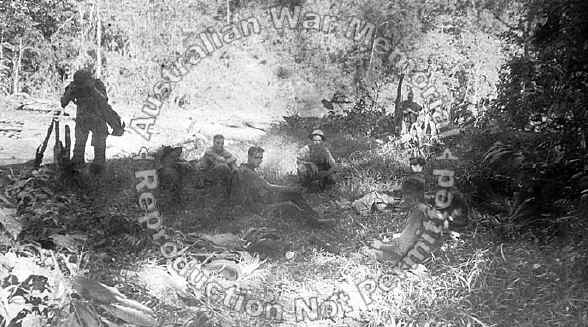 |
| Bainings
Mountains, Gazelle Peninsula, New Britain. 1942-01. Some of the
Australian troops retreating from Rabaul, following the successful
attack by Japanese forces on 1942-01-23, take a rest on the track
through the Bainings Mountains. From left to right: unknown; David
Andrew (Dave) Laws, a member of the New Guinea Volunteer Rifles
(NGVR), who was the Australian and New Guinea Administration Unit
(ANGAU) radio superintendent in Rabaul; S156941 Signalman (Sig)
William F. (Bill) Lord; T44271 Sig Dan J. Thomson; S18167 Sig G.
(Shorty) Barwick; unknown; unknown; unknown; and unknown in
background. This photograph was taken in late January 1942 as
N14130 Sergeant Leslie Ian Hamilton (Les) Robbins and his party
made their way south to Palmalmal Plantation and rescue in April
1942. Dave Laws' local knowledge was instrumental to this party
successfully reaching Palmalmal. Later, P479 Lieutenant Dave Laws,
an ANGAU officer allotted to the Allied Intelligence Bureau and
member of M Special Unit, was killed in action on 5 May 1943 in
the Saidor area, New Guinea. (Donor L. Robbins) |
With the arrival at Rabaul in April
1941 of Lark Force (2/22 Infantry Battalion plus components) NGVR's role
became subsidiary and in August its Headquarters was transferred to
Bulolo on the mainland. Colonel Field relinquished command, and Major
(later Colonel) W H Edwards was promoted to command. One of most
enthusiastic of the early volunteers, Edwards revitalized the unit on
the goldfields of Bulolo and many new recruits came in. War with Japan
was imminent and the strength of NGVR on the eve of the outbreak of war
was 12 officers and 284 other ranks.
Immediately
Japan attacked, Maj Gen B M Morris, commanding the 8th Military
District, was authorised to place the battalion on full-time duty, but
only a small group was then called up and it was not until the 21st Jan
1942 that the battalion was actually mobilised.
The
Japanese attacked Rabaul from the air on the 20th, and in the early
hours of the 22nd effected a landing. When the Japanese came, seventy-four
members of NGVR were in Rabaul under the command of Lt Col H H Carr, the
CO of the 2/22nd Battalion. They manned medium machine guns and mortars
and fought until resistance was of no further avail, sharing the fate of
other prisoners of war. |
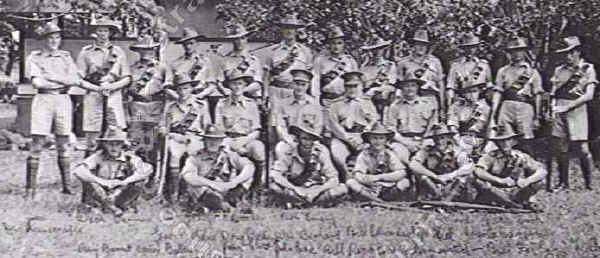 |
- Lae,
1941-06. Members of the Lae platoon of the New Guinea Volunteer Rifles.
- Left to right, back
row: Private (Pte) Des Lanecraple,
Pte Roy Barnett, Pte Heck Baldwin, Corporal (Cpl) Hugh Lyon, Pte
John Glosen, Pte John Cox, Pte Bill King, Pte Harly Armersted,
Pte Bill Fry, Pte Ernie Tulbourm, Pte Bill Edwards (son of
commanding officer captain W. Edwards).
- Middle row: Cpl
George Milne, Sergeant (Sgt) Doug Dickson, Warrant Officer2 W.
N. Bernard, Captain (Capt) W. Edwards, commanding officer, Sgt Syd
Neil, Cpl Charlie Carpenter.
- Front row: Pte
Dick Vernon, Pte George Whittaker, Pte Bob Emery, unknown, Pte Ray
Woods, Pte Jack Cook.
|
| On
the mainland, the NGVR was organised as a group of 'independent
companies' (not to be confused with AIF companies of the same name, with
whom the NGVR later operated) at Wau, Salamaua, Bulolo and Lae. On 21st
January, at about noon, Coastwatcher Pursehouse reported from
Finschhafen that some 60 Japanese aircraft were headed towards Lae and
Salamaua. These divided and struck simultaneously at the two towns.
Systematically and efficiently the Japanese caused destruction and
confusion at Lae. Seven civilian aircraft, which were on the ground when
the Japanese arrived, were wrecked.
As the enemy planes flew away, two
Australian Wirraways of 24 Squadron from Rabaul dropped down out of the
clouds where they had remained concealed and landed on the airfield.
Major E W Jenyns, 2IC of NGVR went to see the administrator, Sir Walter
McNicoll, who had been working from Lae for some time in anticipation of
the final transfer of the capital from Rabaul. Sir Walter agreed that a
state of emergency existed and told Jenyns to 'take over'.
Five Japanese fighters, diverted from
the main force, destroyed three Junkers at Bulolo but, turning east
again before the reached Wau, missed five aircraft on the field there.
At Salamaua, where Pursehouse's report had not been received, the
raiders took the town completely by surprise. They destroyed one RAAF
and 10 or 12 civil aircraft on the ground.
With the knowledge of the Japanese
landing at Salamaua was imminent, and with the NGVR on full-time duty,
there was a general agreement that all civilians should leave the town.
This occurred on 24th January when two parties, one led by District
Officer N Penglase and the other by the Director of District Services
and Native Affairs, R Melrose, departed overland towards the Lakekamu
River, and by sea, respectively.
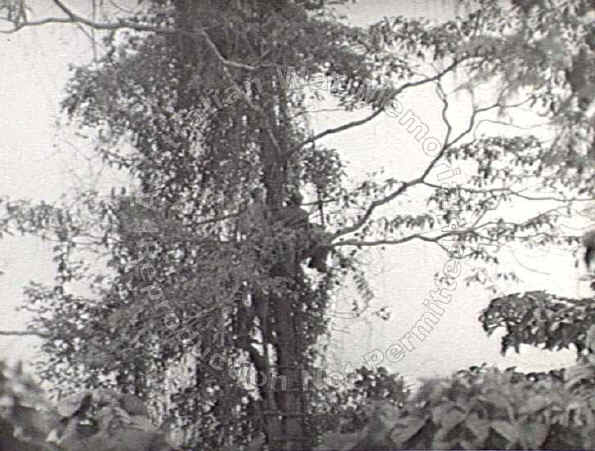 |
| Salamaua
area, New Guinea. 1942-08. NG2191 Sergeant J. B. McAdam, New
Guinea Volunteer Rifles, and Damien Parer, official
cinematographer, observe Japanese movements from a secret tree top
observation post above Nuk Nuk. (film still). |
After their departure, the only
Europeans left in the town were six RAAF men, manning a signals station
and six men of the NGVR. Meanwhile, other scratch NGVR platoons prepared
to defend vital points in the area, with their headquarters at Mubo. A
platoon which went to Salamaua found the small group there in difficulties,
due to local disorders. Lae now had a company strength of men.
On
the 7th Mar 1942, five enemy aircraft raided Lae, which had been laid
waste, and Capt H M Lyon, OC of the group, got word that a big convoy
was headed in his direction. He himself stayed in the town with four men
to await events while the rest of his men made for Nadzab, destroying on
the way the one remaining petrol dump at Jacobsen's Plantation. At
4.45am on the 8th, the Japanese came ashore and Lyon, his men and three
New Guinea natives turned their backs on the lost town and went up the
main road towards Nadzab.
That same morning the Japanese landed
at Salamaua, and the bulk of the NGVR platoon fell back across the Francisco
River, leaving behind a few men to demolish the aerodrome and fire the
petrol dump. As Capt AG Cameron and his runner, L/Cpl Brannelly - two of
a small party of 2/22 Battalion survivors - were falling back, Brannelly
shot an enemy soldier at point blank range, probably the only Japanese
casualty from land action in the landings at either Lae or Salamaua.
After the rear party had crossed the bridge over the Francisco, and when
the Japanese appeared on its approaches from the Salamaua side, the NGVR
men destroyed it. Most of them then took the track back to Mubo.
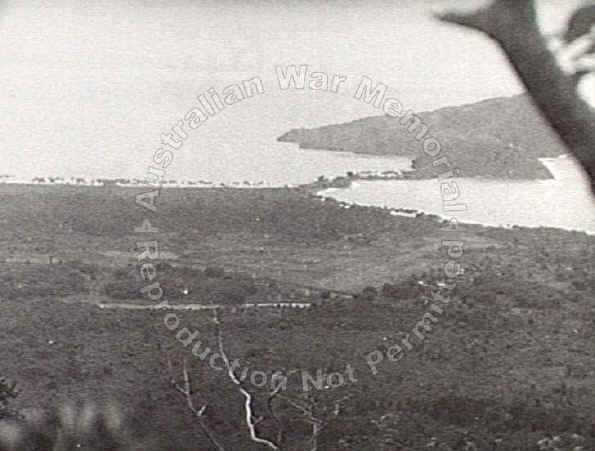 |
| Salamaua,
New Guinea. 1942-08. View from the observation post above Nuk Nuk,
manned by members of the New Guinea Volunteer Rifles. The cleared
area in the centre is the airstrip. Salamaua itself is situated on
the flat isthmus linking the promontory and the mainland.
|
The Japanese displayed no hurry to
move inland. on 18th March, a party of sixty marched to Komiatum,
destroyed the NGVR stores dump there and returned to Salamaua. On the
Lae side, the invaders kept to the township area. This pause on the part
of the enemy gave the New Guinea men time to meet new problems. These
men of the NGVR were the only representatives of the law and order
previously maintained by the administration.
With civil government gone, they
assumed responsibility for several thousand indentured labourers
recruited from many outlying districts by planters and others, and now
unable to return to their homes. The NGVR established depots and fed
them and they became the first of the army of carriers and labourers so
vital to the Allies during the fighting that followed.
Colonel Edwards was most interested to
know what the Japanese were doing in Salamaua, so Cpl (later Major) J.B
McAdam, with a party of six men, edged so close to the enemy that
scarcely a Japanese movement escaped them - they scouted into the very
fringes of the garrison and only their superb bushcraft, hardiness and
courage ensured their survival.
The Japanese knew they were there and
on one occasion a searching party actually passed beneath the telephone
line, but failed to see it. As the local people were being condemned for
assisting the Australians, McAdam withdrew his men to avoid further
trouble for them. Other posts of the same nature were established along
the Markham and Heath's Plantation to watch the Japanese. Little the
enemy did escaped the notice of the watchers.
The
men of the NGVR had filled a large gap in the period up to late May -
they had kept in touch with the invaders. On the 23rd of that month, the
first troops to share their task arrived. Flown from Port Moresby to the
Bulolo Valley, the 2/5 Independent Company AIF arrived to co-operate
with the NGVR. These two units, plus some details from Port Moresby, a
mortar platoon and a group of reinforcements for the widely dispersed No
1Independant Company, formed Kanga Force, with the role of a
'limited offensive' and the object 'to harass and destroy enemy
personnel and equipment in the Markham District (including Salamaua in
that area).
Major NL Fleay, OC Kanga Force,
considered there were 2000 Japanese at Lae and 250 at Salamaua, as
against 700 men under his own command, of whom only 450 were fit for
operations - a pitifully small number to meet any one of the possible
Japanese threats. To forestall these, Fleay proposed to engage the
Japanese by raids designed to inflict casualties, destroy equipment and
to hamper their use of Lae and Salamaua as air bases. Accordingly, he
issued orders for raids on Heath's Plantation and Salamaua and, as the
need for action was urgent, directed that the one on Heath's was to take
place first. As it transpired, however, the Salamaua raid was made
first. It could be planned quickly and in great detail, as a result of
the work of Cpl McAdam's scouts.
In the early hours of the morning of
29th June 1942, 71 members of the 2/5th and the NGVR killed at leat 100
Japanese at a cost of three men slightly wounded. The raid was an
outstanding success and thoroughly disturbed the Japanese, who sent
fighting patrols up to 90 strong into the foothills. The raid also made
them draw on their garrison at Lae to reinforce their perimeter at
Salamaua.
The raid on Heath's Plantation at Lae,
equally well-planned and carried out by 58 strongly armed men, was
successful, but barking watch-dogs warned the enemy of the raiders'
presence and the operation was robbed of the element of surprise that
has been so valuable at Salamaua. In the raid, the leader, Major T P
KEEN was killed and two men were wounded.
As a result of these guerrilla raids,
the men were in good spirits, although many of the NGVR were sick with
fever and the number of fit men dwindled steadily. The most serious
problem, however, was one of supply. Food was not getting through and,
in this regard, the guerrillas were totally dependant on the local
supplies. Japanese air raids, intimidation tactics and the difficulty of
getting rations forward to feed carriers had a cumulative effect and
threatened to stop any activity on the part of the Australians. The
shortage of tobacco was a particularly irritating problem.
In
the months that followed, attention was focussed on the Battle of the
Owen Stanleys (KOKODA), but the NGVR continued to man posts over-looking
the Japanese although their numbers were shrinking. They fought
splendidly, true to the tradition they themselves has established. 1942
WAS THEIR YEAR. By the early months of 1943, too few were left to be
effective. In view of their specialised knowledge of the county and its
problems, the remaining members were distributed throughout Australian
New Guinea Administrative Unit (ANGAU) and the New Guinea
Volunteer Rifles lost its identity.
- The members of the NGVR had come
from many walks of life. Some were too old to join the AIF, some
medically unfit or employed in restricted occupations. But they
fought well and still found time for important administration and
for laying down an organisation of local labour that later grew to
be a most important contributory feature of the success of the
Allied campaign in New Guinea.
The
NGVR involvement in the BATTLE for RABAUL -
At about 1640 hours on 20 Jan 1942, Sgt Ryan of NGVR (European School
Teacher) of RABAUL came to the New Guinea Club where a number of
Europeans were gathered. Ryan was in the uniform of NGVR. He approached
several of us individually who had been training with the NGVR. ,br>
To me he said, "Will you be available to muster on the Parade
Ground as soon as possible to go into Battle Station tonight?" I
believe Sgt Ryan was acting under instructions from Lieut Geoff Kilner,
OC Rabaul Detachment NGVR. I replied that I would make the necessary
arrangements, it being my intention to do military duties during the
night and resume my civilian work in the daytime if required.
Les
Corbett was one other in the Club at the time who to my knowledge made
similar arrangements.
|
|
This
is taken from records held in National Archives of Australia - Series J
2810 R707/1/1. This summary of the history of the New Guinea Volunteer
Rifles was written by Mr C F Coady of the Australian War Memorial
Canberra. |
|